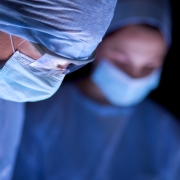A posterior cervical microdecompression is a minimally invasive spine surgery that removes damaged spinal discs through the back of the neck. This procedure is usually recommended for patients experiencing neck pain, stiffness, numbness and/or tingling in the shoulder, arms and hands from a pinched nerve in the neck. There are some advantages to the posterior approach, versus the anterior approach for this surgery. Generally, a spine fusion is not needed after removing the damaged disc through the back of the neck, which preserves the normal functioning of the cervical spine.
Dr. Mark Giovanini of NeuroMicroSpine performs both posterior cervical microdecompressions and anterior cervical discectomy and fusions to patients experiencing significant neck pain. Dr. Giovanini will examine your current symptoms, spinal condition and health history to determine which procedure will be right for you. A posterior cervical microdecompression is typically considered for patients with disc herniations lateral to the spinal cord.
 The surgery requires a small incision in the back of the neck where a tubular retractor will then be placed for access to the spine. The procedure does require moving the para-spinal muscles and nerve root within the neck off the spinal column so that the surgeon can free up the disc herniation. Bone, disc material and/or thickened ligaments are then removed to relieve pressure on the spinal cord and nerves. After this task has been completed, the retractor will be removed and the incision will be closed.
The surgery requires a small incision in the back of the neck where a tubular retractor will then be placed for access to the spine. The procedure does require moving the para-spinal muscles and nerve root within the neck off the spinal column so that the surgeon can free up the disc herniation. Bone, disc material and/or thickened ligaments are then removed to relieve pressure on the spinal cord and nerves. After this task has been completed, the retractor will be removed and the incision will be closed.
Like with most surgeries, there are potential risks/complications patients should be made aware of, which Dr. Giovanini will go over in-depth if you are a candidate for the surgery. Nerve root damage, spinal cord damage, infection and bleeding could occur. Also, because the posterior approach leaves parts of the disc in place, there is a 3 to 5 percent chance a disc herniation may recur in the future.
However, there are many advantages to undergoing a posterior cervical microdecompression. As mentioned previously, the posterior approach help preserves the motion of the spine and can also provide a shorter recovery time. Patients are usually discharged from the hospital or outpatient surgery center the same day as the surgery. Improvements can happen immediately or gradually after surgery—results vary from patient to patient. Call NeuroMicroSpine today if you’re experiencing neck pain and would like to discuss the possibility of a minimally invasive spine surgery.
For more information on minimally invasive spine surgery or to make an appointment with Dr. Giovanini, please call (850) 934-7545 or visit http://www.neuromicrospine.com/request-appointment.
We hope to see you soon!
The advice and information contained in this article is for educational purposes only, and is not intended to replace or counter a physician’s advice or judgment. Please always consult your physician before taking any advice learned here or in any other educational medical material.
©NeuroMicroSpine, 2015
©Medical Marketing Solutions, 2015
